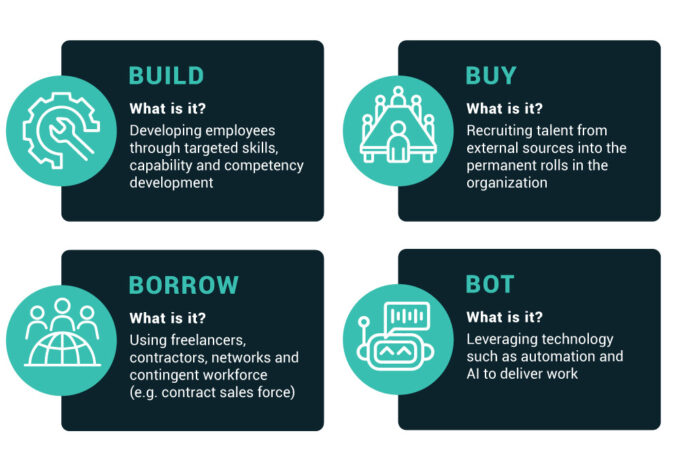
Three ways to deal with the almighty boss
What to do when those in positions of authority behave in ways that contradict widely accepted norms of civility, empathy, and ethical leadership....
Audio available

by Tania Lennon Published 23 April 2024 in Talent • 8 min read
In the last 10 years or so, the 4B framework has passed into strategic talent planning lore, helping CHROs everywhere identify and address their organization’s growth and human capital needs.

And it works by simplifying the kinds of trade-offs you face in your HR strategy. You can choose to BUILD organizational capabilities by investing in your existing talent and you’ll avoid talent acquisition costs, but the time it takes you to upskill your workforce for tomorrow means you might not be able to meet urgent talent gaps today.
Alternatively, you might want to BUY in new talent to drive growth and benefit from a quick talent boost, but it may cost you in terms of price and integration. Maybe you opt to BORROW talented freelancers, contractors, networks, or interim workers to plug a skills gap, but then you face the risk that external talent isn’t as committed and engaged as your full-time workforce. And if you opt for BOTs such as AI and other digital technologies, you’ll likely be able to service high-volume, repetitive work, but at what cost in terms of establishment?
Over the past decade, the 4B framework has solidified its place as a key component in the CHRO toolkit. However, is it time for a refresh?
A comprehensive review by the IMD Strategic Talent Solutions team would suggest so. We explored whether in today’s volatile business context, shifting environmental factors and dynamics could be reshaping the comparative value of the 4Bs. We wanted to see if the trade-offs remain stable in terms of building, buying, borrowing, and implementing bots in the context of the changing world of work.
Here are the five trends we believe CHROs need to have on their radar.

“In contrast, the talent acquisition of BUY strategies may become less useful, as rapid changes in skill requirements may leave organizations with highly skilled workers in areas that no longer drive value.”
Skill obsolescence is happening. And it’s happening faster than ever before. Changes in job requirements and technology mean that up to 15% of requisite skills today will be automated within the next three years. Meanwhile, the WEF Future of Jobs reports that 44% of worker skills will be significantly disrupted between now and 2028. What does this mean for you and the 4Bs of talent planning?
Primarily, it means organizations will need to invest more in BUILD strategies, becoming more flexible and adaptable through their culture and processes to support learning and rapid knowledge acquisition with employees empowered to identify and acquire the skills they need for success.
In contrast, the talent acquisition of BUY strategies may become less useful, as rapid changes in skill requirements may leave organizations with highly skilled workers in areas that no longer drive value. By the same token, rapid advances in technological innovation can accelerate depreciation in (expensive) investments in BOTs.

As automation and digitalization take over the analytical and repetitive work in organizations, what’s left over will tend to become more complex, nuanced, and interdependent. This entangled work requires either deep specialists who are able to navigate complexity or, more frequently, collaborative work involving different functions, expertise areas, and perspectives.
Drawing together these diverse perspectives can enable competitive advantage by capitalizing on “collective intelligence” (Woolley, 1998) for innovation. On the flip side, collective intelligence requires both high- quality relationships and active participation and engagement from team members — qualities that are harder to elicit from temporary or networked team members. In this scenario, BORROWing talent becomes a less attractive approach.
A better bet might be BUYing specialist capabilities and integrating them with the advanced skills you have developed by BUILDing and developing in-situ talent — with the added advantage of conferring greater resistance to obsolescence and sustained long-term career value through the development of more sophisticated soft skills (Deming & Noray, 2020).

According to CRM giant Salesforce, 66% of consumers today expect companies to understand their unique needs and expectations, while 52% expect interactions with companies to be personalized. Meanwhile, organizations are increasingly co-creating with customers, or even handing the design process over to consumers to allow customers to shape it to meet their needs (Pallant et al.,2020).
IMD’s Frederic Dalsace describes this as a shift towards “caring more about how the customer feels when they buy … or when they hire the company to do the job.” Getting it right calls for deeper insight into customers’ needs, preferences, and emotions and more expertise in creating integrated, personalized solutions.
This, of course, is not easy. Some research suggests it can take up to 18 months to build engagement. And while BOTs can handle much of the “grunt work” in personalization — the decision engines that underpin omnichannels, for instance, real engagement is more typically the product of human interaction. For CHROs, this means two things. BUYing talent might pay off if your incoming people bring strong existing relationships with them, but as a strategy, it might take time to yield dividends. Meanwhile, BORROWing workers is unlikely to yield much advantage, as more transactional sales journeys are better handled by BOTs.

Contracts between organizations and employees are psychologically complex — they are both transactional and relational. Yet one thing remains prevalent: Most people want exciting and challenging work characterized by increased scope or complexity.
Promotion can seem like the best pathway to achieve this, as well as providing a boost in salary to offset economic pressures. But in today’s flatter organizational structures, upward progression is becoming harder to attain. BUILDing as a strategy has some advantages here. First, it gives employees more of the stretch they are looking for , via job enrichment, job crafting, and lateral job moves. Second, with the right progression planning support, BUILDing strategies can enable organizations to access a wealth of talent with minimal acquisition costs.
Finally, CHROs will want to be mindful of the pitfalls of BUYing and BORROWing approaches in the context of employee expectations — they can be seen as frustrating and unsupportive of incumbent workers’ development needs and aspirations.
In the IMD Talent Lab, for instance, we are leveraging advanced data analytics based on complex synergetic models to help pinpoint where and how individuals are most likely to benefit from investing time and resources in their development to support their progression.
According to organizational psychologist Tomas Chamorro-Premuzic, CHROs should adopt a data-driven approach to talent management, eschewing “common sense and intuition” for “validated tools.” these tools are developing fast. Advances in analytics are yielding tools that are more predictive and prescriptive than descriptive and diagnostic (think personality assessment tests and the like.).
In the IMD Talent Lab, for instance, we are leveraging advanced data analytics based on complex synergetic models to help pinpoint where and how individuals are most likely to benefit from investing time and resources in their development to support their progression. Similarly, new mechanisms using immersive technology-enabled techniques, such as game-based assessments, now have the potential to collect thousands more data points — information that offers a much richer and more integrated perspective on individual capabilities (Landers & Sanchez, 2022).
While such advancements benefit BUYing strategies through better talent acquisition, they also have the capacity to enhance BUILDing efforts, leveraging the kinds of precise and personalized needs analysis that can increase the impact of development on performance.

“As technological innovation continues to disrupt our systems and processes, BOT as an approach will be an increasingly valuable approach.”
So, what does all of this mean for you and the way you use the 4B talent planning framework in your organization?
While we believe these trends and insights underscore the value of each of the four strategies in the modern workplace, they do perhaps point to BUILD as a more effective workforce planning tool — one that should be enabled by enhanced analytics and new assessment methods, with ancillary benefits for retention and a stronger psychological contract.
As technological innovation continues to disrupt our systems and processes, BOT as an approach will be an increasingly valuable approach. Automation and digitalization offer a solid foundation for addressing changing commercial needs — but alone, they are not enough to address the human-to-human connections that drive engagement, retention, innovation, and customer insight. Used judiciously, BOT is a foundational strategy that can be BUILT upon to harness the unique talents and creativity of our people — people whose creativity and ingenuity have the potential to drive growth and value creation to a greater extent than ever before.

Executive Director of the Strategic Talent Development initiative
Tania Lennon leads the Strategic Talent team for IMD. She is an expert on future-ready talent development, including innovative assessment methods to maximize the impact of talent development on individual and organizational performance. Lennon is a “pracademic”, blending a strong research orientation with evidence-based practice in talent development and assessment.

14 March 2025 • by Merete Wedell-Wedellsborg in Human Resources
What to do when those in positions of authority behave in ways that contradict widely accepted norms of civility, empathy, and ethical leadership....
 Audio available
Audio available
4 March 2025 • by Ginka Toegel in Human Resources
Current and aspiring women leaders may be self-conscious about their appearance, but strategies for developing an authentic professional style can redirect attention to their achievements, as they dress for comfort and confidence....

20 February 2025 • by Katharina Lange in Human Resources
Understanding generational differences is crucial to unlocking potential, retaining talent, and becoming a more effective leader. ...
 Audio available
Audio available
27 January 2025 • by Didier Bonnet in Human Resources
No one expects CHROs to become technical experts, but with a firm grasp of the fundamentals they can help shape an intelligent approach to AI adoption ...
Explore first person business intelligence from top minds curated for a global executive audience